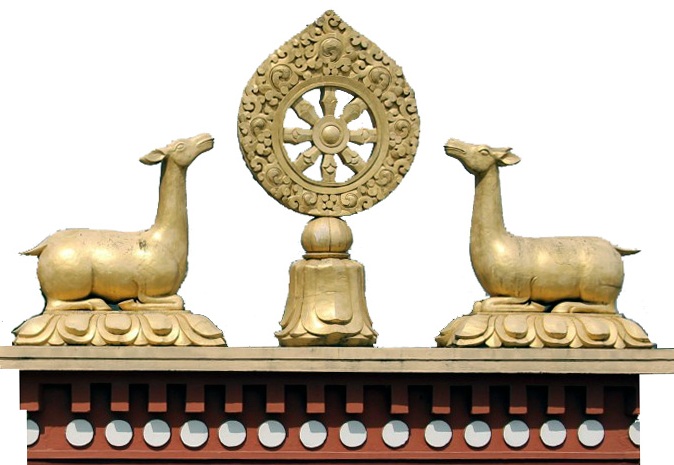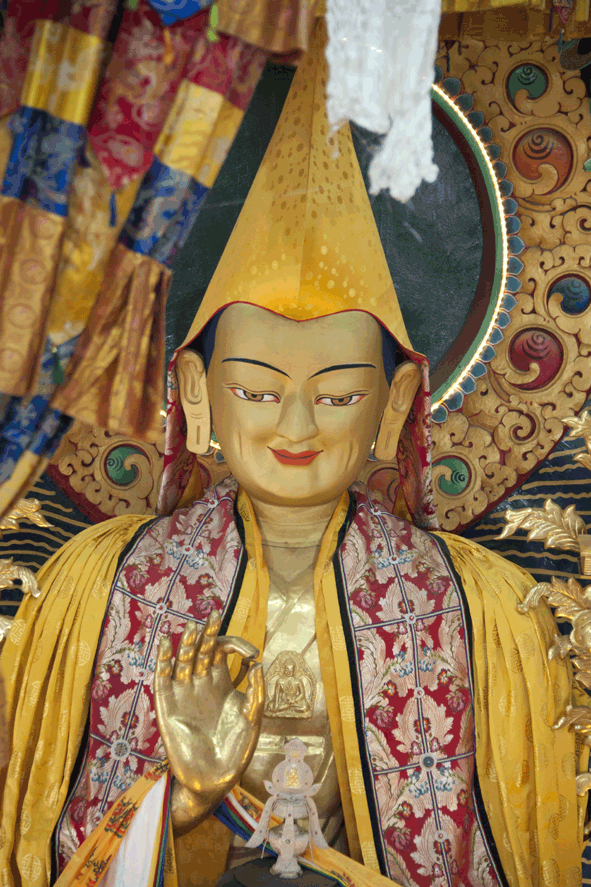Symbolic features of the Traditional Tibetan Temple (Gompa)

On the roof or over the front entrance of most temples is the symbol traditionally seen on all Tibetan monasteries - the Dharmachakra, flanked by two deer.
The deer are peaceful animals considered to represent compassion and peacefulness. One is male and the other female, indicating harmony, happiness and fidelity. These particular deer have a single horn and are known as the Tibetan unicorn. It is a magical deer which only manifests in the presence of great teachers. The deer gaze up at the Dharmachakra symbolizing the aspiration for the Dharma.
The Dharmachakra, or the wheel of Dharma, represents the three turnings of the wheel of the Dharma by Shakyamuni Buddha. Its three major parts – hub, rim and spokes – represent the three higher trainings, the path to liberation from samsara. The hub is for higher training in ethics, the rim representing the higher training in concentration, and the spokes stand for higher training in analytical wisdom. The eight spokes point in the eight directions and represent the Buddha’s noble eightfold path The Dharma wheel destroys all obscurations: the obscurations to liberation and the obscurations to omniscience.
Around the parapet are golden disc-like ornaments each of which is a representation of one of the Eight Symbols of Good Fortune and the Five Qualities of Enjoyment. These again are seen on all traditional Tibetan meditation halls.
The gold painting of the roof and porch, the Dharmachakra, deer, victory banners, spires and lotus petals, and the decorative painting are all reminders of the Dharma. They are found in the traditional Tibetan temples of India and Tibet.

As you enter the hall, the statue of Lama Tsong Khapa towers above, a magnificent statue 15 feet high, filled with the symbols of the vajra body, speech and mind of the Buddha in the form of mantras, and precious things. It is surrounded by the carved images of a traditional altar.
On the side railing silk thangkas are displayed, representing the two supreme masters and seven sage ornaments, as well as Manjushri, Maitreya, White Tara and others.
The four pillars represent the four wisdoms, which we have to acquire on the path to Enlightment.

The windows around the top are symbolic of the wisdom eyes, the all-seeing, omniscient quality of the Buddha. The statues on either side of the main statue are representations of Shakyamuni Buddha, Maitryea Buddha, Tara, Atisha (who brought the Dharma to Tibet), the two disciples of Lama Tsong Khapa, Medicine Buddha, and at the far end a life size statue of our founder, Lama Yeshe.
The temple is blessed by the presence of the Tibetan canon of the Translated Word (Kagyur) and Translated Commentaries (Tengyur).The translated word is the texts of the collected sutra and tantra teachings of Shakyamuni Buddha and can be considered to represent the Buddha’s holy speech. The Translated Commentaries are the collected works of the great Indian Pandits, such as Nagarjuna, Asanga, Chandrakirti and so forth.
Our temple is the result of a beautiful coming together of design, craftsmanship, symbolism, Buddha image, thangkas, the Buddha’s Word, and the vision of our spiritual leader. It is our place of Dharma, of teachings, empowerments, blessings, tantric pujas and retreats. It holds the hope of enlightenment, the welfare of beings, and extends the opportunity of truth to all who would hear.

Outside the door in the front vestibule are depictions of the four great Tibetan Dharma Kings, the Wheel of Life, and on the right hand side, the possessions of a monk, with the drawing of the path to the attainment of calm abiding over the door.
You will see many representations of the eight auspicious symbols throughout the meditation halls.
- The Precious Parasol is a symbol of protection, as a parasol protects from the sun. The coolness of its shade protects one from the heat of delusion, suffering, obstacles, illness and harmful forces.
- The Golden Fish are a symbol of happiness as the fish have complete freedom in the water. They represent fertility and abundance as they multiply rapidly.
- The Great Treasure Vase, the divine vase of inexhaustible treasures, represents the spontaneous manifestation of all that is wished.
- The Lotus represents purity and the renunciation of samsara.
- The right-turning Conch Shell represents the reputation of the Buddha’s teachings that are expanding in the same way as the sound of the conch penetrates the ten directions.
- The Glorious Endless Knot overlaps without beginning or end and symbolizes the Buddha’s endless wisdom and compassion. The intertwining of the lines reminds us of dependent origination, the underlying reality of all phenomena.
- The supreme Victory Banner symbolizes the Buddha’s victorious enlightenment and victory over Mara - the leader of destructive influences and obscurations.
- The Wheel is the wheel of the Dharma. It represents the three turnings of the wheel of the Dharma by Shakyamuni Buddha and its symbolism is as explained earlier.
The Symbols of the Five Qualities of Enjoyment
- The Mirror symbolizes the offering of the uncontaminated enjoyment of pure forms.
- The Lute symbolizes the offering of the uncontaminated enjoyment of pure sounds.
- The Incense vessel symbolizes the offering of the uncontaminated enjoyment of pure smells.
- The Fruit symbolizes the offering of the uncontaminated enjoyment of pure tastes.
- The Silk symbolizes the offering of the uncontaminated enjoyment of pure tangible things.
There are two additional symbols
- The Precious Coral which symbolizes good conditions.
- The Precious Rhinoceros Horn which symbolizes good health and energy.